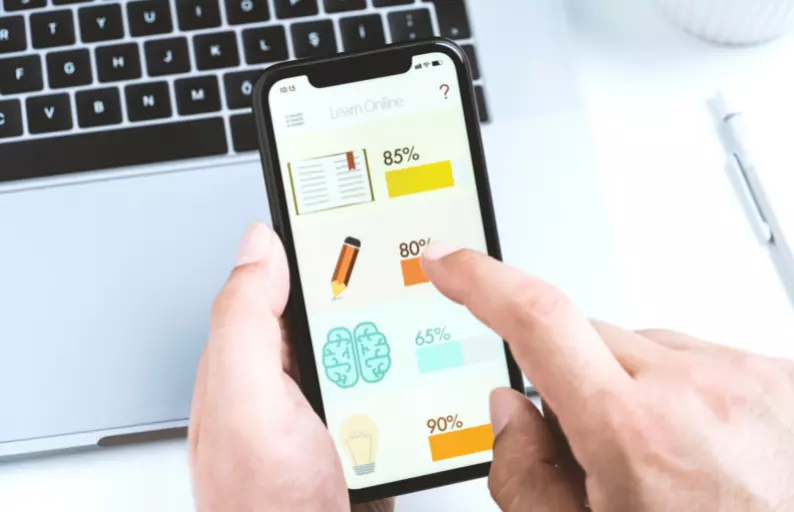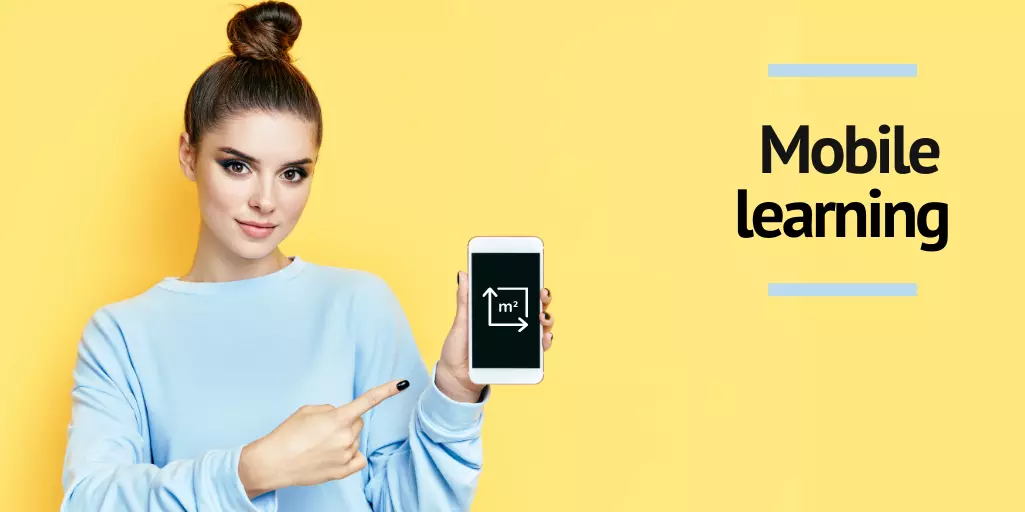What is M-Learning in and out of the classroom
The mobile phone is an essential accessory in our lives.
We use it for everything: calling, surfing, listening to music, reading e-books, watching TV series, browsing social networks, shopping…
If we go through life with one eye here and the other on our mobile, it is not surprising that new uses for this technology are emerging every day. For example, m-learning in education, which makes the most of the mobile phone when it comes to studying.
The M-learning meaning is a practice that improves teaching-learning processes from a mobile device (smartphones, tablets or other devices with wireless connectivity).
The great thing about m-learning is that it makes learning available to students when they are not in a specific location. That is, while they are ‘mobile in hand’ and without the consequent limitations of time and space.
M-learning, a nuanced branch of e-learning methodology
If elearning is learning that is offered over the internet, what is m-learning? Easy, it is the one that relies solely on mobile devices.
As you can see, the main difference between e-learning and m-learning is how the training will be consumed.
But it is also very important to know that e-learning:
- It is a complete alternative to classroom lectures
- It supports long sessions
- Portability and mobility is regular
- The size of the screens makes it possible to view a greater amount of complex content
- Access to training is through an e-learning platform
In contrast, m-learning:
- Is focused on shorter sessions.
- The study is consumed from a mobile or tablet, especially by downloading apps.
- It is a more spontaneous type of learning, as the student accesses the content when they feel like it.
In no case does m-learning in education replace e-learning. It should be borne in mind that learners do not use their mobile phones for continuous learning, but access information ‘on the go’. This makes mobile learning highly advisable as a support formula for e-learning.
M-learning advantages and disadvantages of introducing it in the classroom

Advantages of M-learning in education
Now you already know what is m-learning. It is time to discover the advantages of turning the mobile phone into your ally are many!
Include mlearning in your online course study methods for reasons such as these:
Easy access and flexibility
The student learns when and where he/she wants, and can consult the information whenever he/she wants. They only need a mobile device with an Internet connection.
Digital skills development
Students broaden their competences by learning to navigate between search engines, reliable sources and apps or various study tools.
Collaborative learning
Because they are connected devices, interaction is immediate and increases communication between tutor and student or between different students.
Rewarding and convenient experiences
Content can be consumed in small amounts, without requiring long sessions or being located in a specific physical space.
Motivation and participation
Learning is fun, so making games and applications available is encouraging and beneficial for assimilating knowledge.
Dialogue and immediate feedback
Students are in constant contact with the teacher, which allows them to resolve any doubts instantly.
Live monitoring of activities
Having the course available on the mobile makes it possible for students to keep up to date with everything that is happening (event, assignment, work, calendar…).
Opportunities to generate content
As a teacher, you have access to a multitude of information in infinite formats and to tools that will help you with projects, group tasks…
Fluid communication at all times
Information can be exchanged in real time or asynchronously. Chats or forums facilitate communication between students, and between students and teachers.
Saving time and resources
Learners consume content autonomously and efficiently, without the need for a teacher to intervene.
Possibilities to evaluate and implement improvements
Learner feedback will help to determine the effectiveness of the course and to devise future content with the necessary corrections.
Technological compatibility
The number of people opting for e-learning is growing at a dizzying pace. Thus, new products such as HTML5 language have been developed to avoid any type of error related to technology incompatibility.
Gamification
Mobile devices are an extraordinary platform to offer learners a more user-friendly learning environment. More and more M-Learning courses are using games and applications with content.
Disadvantages, albeit minimal
What do you think will happen if your students receive a WhatsApp or a notification from another app?
It is very likely that they will put aside their studies to focus on the new entertainment.
The mobile phone brings with it a high level of distraction. For this reason, you need to teach your students how to engage with the mobile, solve their doubts and make them aware of the convenient and responsible use that this technology requires.
There are also some drawbacks to mlearning:
Viewing content on small screens
The smaller screens make reading difficult and not entirely pleasant.
Lack of adaptation of teaching material
Increased learning curve
Especially for those who are not familiar with new technologies, but once they have some knowledge, they will progress quickly.
Space consumption, lack of wifi or malicious software
Downloading apps or PDFs takes up space on the smartphone. Threats can arise from storing sensitive information.
Tips for implementing m-learning solutions

As you can see, the mobile phone can contribute a lot to the education of your students.
Now that you know what is m-learning, why not embrace it as soon as possible?
To adopt mobile e-learning you need to consider your learners, their preferences and your learning goals.
Therefore, make a good planning by analysing these parameters in depth:
- The learning goal to be achieved
Analyse whether mlearning is compatible with the goal you set for your course. At all times it must provide advantages.
- The learners
Know who they are and talk to them. Find out their average age, their ability with technology, the time they spend on their mobile phones…
- Device type and connectivity
Do they have the right mobile technology to access your content?
Make sure your material matches their devices and that they will have wifi connection.
- The possibilities for adapting and targeting learning material
Reduce your content to pills or learning units that can be consumed in short periods of time. Prepare material that captures their interest and that your learners will not abandon for other distractions.
- How to measure success
It is important that you track the experience. Use tools that allow you to confirm that you are fulfilling your purpose (satisfaction surveys, evaluation instruments…).
Responsive content in M-learning
E-learning courses are not only consumed through the computer, because nowadays users access from any device when it comes to carry out their training, regardless of its shape or size. That is a reason to use it when you want to answer to what is m-learning?
Then, it is time to ask the main question: are your courses perfectly adapted to the multi-device needs of these users? This is when responsive content comes into play, which is responsible for adapting the design of your websites to the different screens.
We know that at first glance it seems a bit intimidating, but the truth is that responsive e-learning is simpler than you think. It’s really just automatically rearranging the same content of your course in relation to the size of the different screens.
As you know, what can be easily read on a large screen can become complicated on a smaller screen. This is why responsive content becomes an essential ally in the e-learning world, as it makes reading easier so that meaningful learning is not interrupted. An aesthetically well-generated design that makes you forget to zoom in and out!
Why is responsive content necessary for companies?
Any company that has opted for e-learning when it comes to training its employees should know that responsive e-learning is essential to carry out this task effectively. This is mainly due to the fact that desktop computers are no longer in use, and their use has shifted completely to smartphones. This is logical, as they allow for ubiquity of information at the click of a button.
It is no longer simply a question of Millennials, but of any user. In fact, numerous surveys have shown that since 2016, more and more people are choosing to take online courses via their mobile devices. Even tablets scored higher than desktop computers.
Seen from this perspective, a company’s use of responsive content is a way of giving freedom to its employees, as they will have the power to choose when and how they want to learn.
How to start designing responsive content?
Although there are a number of strategic decisions that need to be made by an expert, when we talk about what is m-learning, so we can highlight some basic points that every online course should consider in order to be successful:
The navigation menu must represent digital simplicity.
Undoubtedly, the first aspect to take into account in order to keep the course well organised is the navigation menu. Therefore, develop one that is as simple as it is concise.
Unnecessary time spent by users to find what they are looking for will have a negative impact on both their goals and your effectiveness.
How complicated are your interactions?
As we have already mentioned, the mobile phone is the main device used to carry out an online course. Therefore, aspects such as right-clicking on the keyboard or complex downloads due to the speed of the Internet have to be considered.
As with the navigation menu, simplicity will result in a better user experience – sometimes less is more!
Laying out your design on a smaller device
Before diving in head first, imagine or test how the elements of your courses will be laid out on a smaller screen.
Pay attention to text, images, interactions… By following these tips, you will allow your collaborators to identify what information is most important in your project. You will be their digital guide!
In addition to being uncomplicated, responsive e-learning is a boon for the future.
Year after year we see new devices being released that are completely different from what we have seen before, which is why you need to arm yourself with a design that has the capacity to adapt to new trends. Without a doubt, we can consider it as a kind of digital lifeline.
M-learning examples. How to innovate in the classroom

Uses to support educational activity
There is a very wide range of possibilities for applying m-learning inside and outside the classroom.
Here are some mlearning examples:
- Searching for information on the web
- Consult multimedia material, books, dictionaries, digital encyclopaedias, etc.
- Sharing files and information related to the subject (and promoting interaction)
- Creating training pills and all kinds of activities
- Create e-books
- Download educational apps
- Suggest reference or teacher's own podcasts
- Generate a library of images, videos, podcasts...
M-learning tools and apps to bring fun to your classes
Finally, now that you know what is m-learning, its advantages and tips, you should know the best m-learning applications and incorporate some of them in your day-to-day work.
These are great for any subject and any level of difficulty:

Kahoot is a learning platform for creating, sharing and playing games in the classroom, at work or at home. You can organise live games via video conferencing or hold trivia quizzes to keep your students guessing. With Kahoot, you can assess learning progress and see what they think about certain topics.
In short, we can understand what is m-learning as a support for e-learning.
In fact, some e-learning platforms, such as evolCampus, allow students to participate in their courses through their mobile devices.
Remember that the educational process has no limits, so help your students and achieve an attractive course with the opportunities provided by the use of mobile devices.


